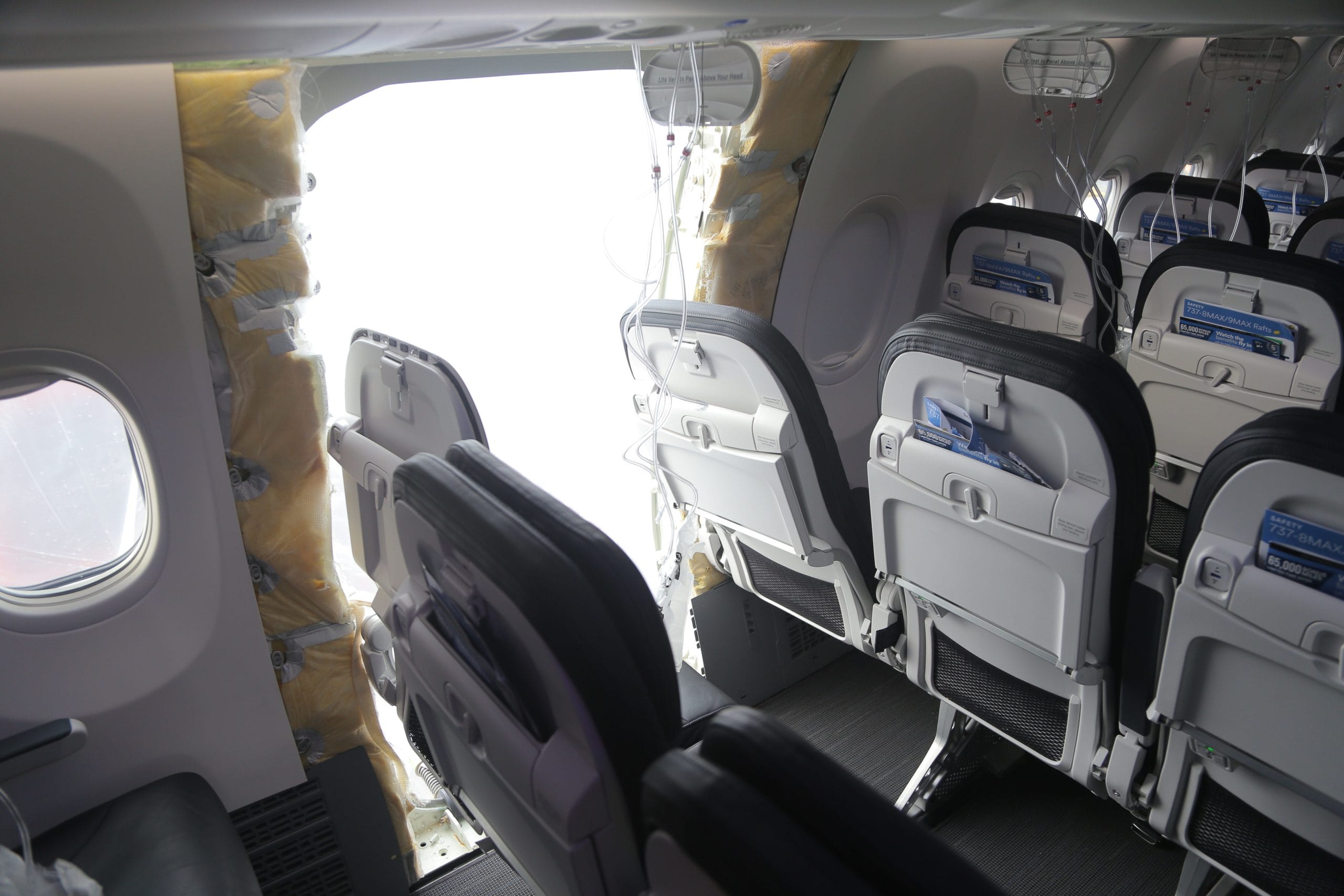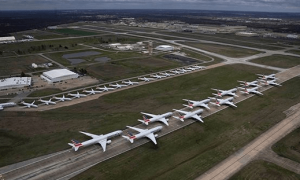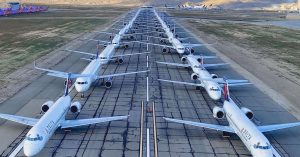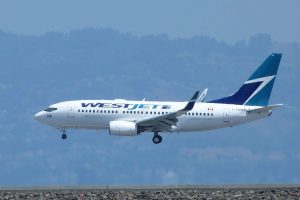On January 5th, an airplane lost a fuselage panel covering an unused emergency door. It happened during the flight, but thankfully without major injuries. The aircraft involved is a variant of the Boeing 737 MAX, a plane model that had been grounded in the past due to an (unrelated) more major issue.
I will also share with you an article on how to identify the type of aircraft operating your flight in a separate article soon.
Here’s what you need to know about the Boeing 737 MAX 9 incident.
Overview of the Boeing 737 MAX 9 incident
Here’s the basics:
- An incident occurred on January 5th over Oregon
- On an Alaska Airlines Boeing 737 MAX 9
- A fuselage panel detached during the flight
- This panel is used to plug an unused emergency door
- The aircraft landed safely
- There were just 3 minor injuries
- The model has been grounded by U.S. authorities
For context, there are nearly 30,000 commercial aircraft in operation worldwide, and only 215 of them are Boeing 737 MAX 9s.
The fact that nobody understands aircraft models is a big running gag for us in the aviation world.
So here are a few additional details:
- There are 1400+ Boeing 737 MAXs in service
- 215 are Boeing 737 MAX 9s (those are the ones involved)
- Some of the 215 don’t have this door plug (not affected)
- The remaining 1200+ are 737 MAX 8s (not affected)
- There are 10,000+ Boeing 737s without the word MAX in their name
- 100% of these have nothing to do with the Boeing 737 MAX
- These are completely different and distinct aircraft models
- They are therefore not affected either
None of the Canadian airlines operate the Boeing 737 MAX 9. However, the 2 largest operators are just south of the border in the United States: United Airlines and Alaska Airlines. Fortunately, this aircraft represents a relatively small portion of their jet fleets (being a very recent model).
Here’s the impact for travelers:
- The aircraft is temporarily grounded in the United States
- Boeing 737 MAX 9 operators had to cancel several flights
- The canceled or modified flights are eligible for a free refund
- All aircraft will undergo inspection (and repairs if needed)
- The investigation will be completed to ensure safety
Know that commercial aviation remains the safest mode of transportation (by far). Every incident, even the most minor one, is assessed extremely seriously by experts. Procedures, recommendations, and new systems will then be put in place to prevent a recurrence of any incidents.
Finally, here’s what we know about the cause of the incident at this stage:
- The investigation tends to show that some bolts may have been incorrectly screwed in (or even not installed at all)
- Boeing has admitted its error related to the assembly
Here’s more information.
Details of Alaska Airlines Flight 1282
Alaska Airlines Flight 1282 occurred on Friday evening, January 5th, 2024, traveling from Portland, Oregon (PDX) to Ontario, California (ONT).
The flight was operated by an almost brand-new Boeing 737 MAX 9, delivered in October 2023 and put into service in November. Since then, the aircraft had completed 145 flights.
About 7 minutes after takeoff, at an altitude of 16,000 feet, a fuselage panel covering an unused emergency door detached. This caused an uncontrolled decompression of the aircraft, leaving a hole in the fuselage.
There were 3 minor injuries. Objects, including a passenger’s shirt and cell phones, were sucked out through the hole in the fuselage. Surprisingly, at least one phone appears to have survived, despite typically shattering when dropped from a height of less than 1 meter.
The plane then returned to Portland and landed normally.

Reactions to the Boeing 737 MAX 9 incident
Of its own accord, Alaska Airlines immediately grounded all its Boeing 737 MAX 9s for inspections.
The U.S. FAA (Federal Aviation Administration) then officially banned all other aircraft of this model from flying. This includes U.S. fleets and also prevents foreign airlines from using the model for flights to the United States.
European and Brazilian authorities have done the same. This doesn’t necessarily mean that all 737 MAX 9s in operation elsewhere in the world have also been grounded, but that seems to be the case.
Door plug at the origin of the Boeing 737 MAX 9 incident
The fuselage panel in question is called a door plug. It’s a panel that replaces an optional emergency exit. The one on the Boeing 737 MAX 9 is near the rear of the cabin.
In other words, the aircraft is designed to have an additional emergency exit, because it may be required if the airline chooses a denser seating configuration that requires more exits for safe evacuations.
This is relatively common, but you may not have noticed it because from the inside, it looks like a regular window, but from the outside, it is very visible.
You can see what the Boeing 737 MAX 9 looks like when the additional emergency exit is installed (left) and when the emergency exit is not installed, as in the case of the aircraft involved in the incident (right). The contour of the door and the size of the window are the visible differences.
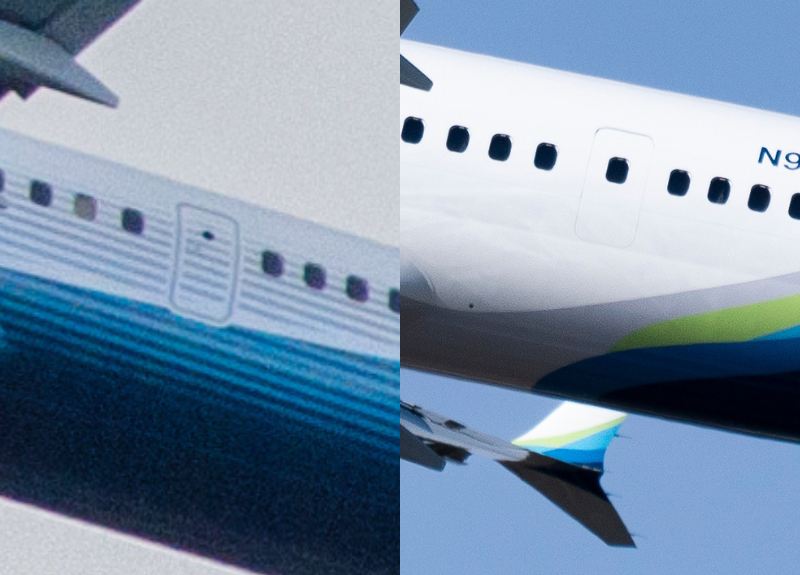
That’s why some Boeing 737 MAX 9s aircraft are not even affected by the issue, as they have a real exit door installed rather than the panel to plug it.
Boeing 737 MAX 9 vs Boeing 737 MAX 8
The problem only affects the Boeing 737 MAX 9 (also known as the 737-9).
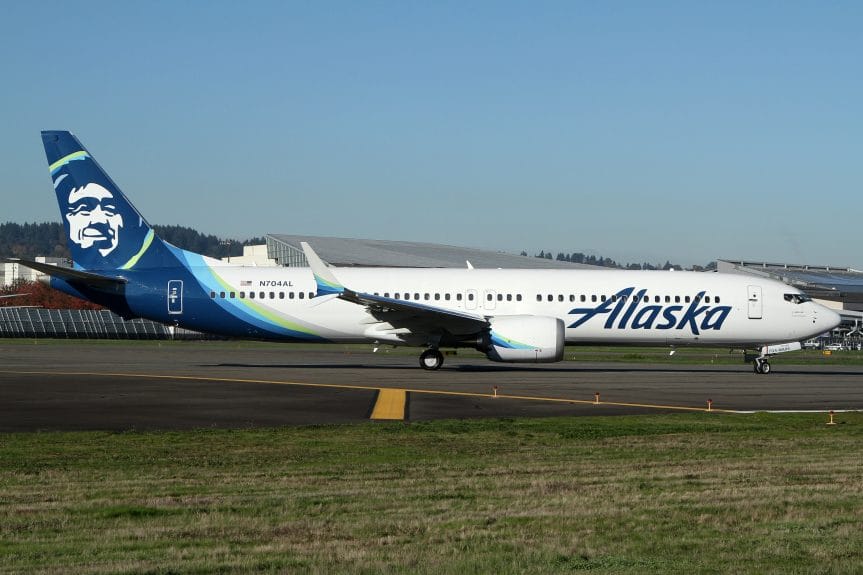
The MAX 8 variant and its sister version the 737 MAX 200 (also known as the 737-8 and 737-8200) are by far the most popular Boeing 737 MAX models, and don’t have the same problem.
The Boeing 737s, without the word MAX in their name (737-700, 737-800, 737-900, etc.), are completely different aircraft and are not affected. These are the 737 Original, 737 Classic, and 737 Next Generation, which are among the most widely used and reliable aircraft. Over one-third of all commercial aircraft worldwide are 737s.
A few 737-900ERs might have some door plug issues as they use the same door plug. The FAA has recommended that airlines inspect them out of an abundance of caution, but this model has flown over 11 million hours for over 16 years without any related incident so you probably don’t need to avoid this one!
Boeing 737 MAX 9 aircraft in Canadian fleets
Note that many Canadian airlines operate Boeing 737 MAX aircraft — but they’re all Boeing 737 MAX 8s, so they’re not affected by this situation.
These include Canada’s 2 biggest airlines, Air Canada and WestJet, the 2 ultra-low-cost carriers Flair Airlines and Lynx Air, and finally Sunwing (which will be integrated into WestJet this year).
Boeing 737 MAX 9 aircraft in other fleets
Outside of Canada and the USA, several airlines use Boeing 737 MAX 9s, so they could still be in service in the air elsewhere (although it’s unlikely).
Among foreign airlines that have confirmed grounding their Boeing 737 MAX 9s, there are Aeroméxico, Copa Airlines, Turkish Airlines, and Lion Air.
Others who operate the 737 MAX 9, but who have confirmed not having the configuration with an unused emergency door are Icelandair, Corendon Dutch Airlines, Flydubai, SCAT Airlines, and Air Tanzania.
To see what type of aircraft operates your flight, the easiest way is to search for your flight details on the airline’s website and look for the “Details” option or equivalent. A more in-depth article will follow shortly.
Third-party booking site KAYAK has even added a filter for plane models in response to the Boeing 737 MAX 9 incident, so you can use it for your search. Reminder of the basics: third-party websites like KAYAK are only recommended for searches and NOT for bookings. It’s better to book your flight directly on the airline’s website if the price is similar.
Flight cancelations due to Boeing 737 MAX 9 incident
As a result, some flights have been canceled by the airlines in question. Take a look at our various tips for dealing with flight disruptions. Some of them may well apply.
We’ve shared so much of this stuff all over the place, one of our plans to get 2024 off to a good start with our new doubled team is to better organize and simplify all our content, so we can help you even more.
In the meantime, at least, you should know 2 basic things, which unfortunately too many travelers don’t.
Firstly, as soon as an airline modifies one of your flights, you’re entitled to a full refund in cash, free of charge (and not the terrible travel credits/vouchers you should always avoid).
That’s why you should never cancel a flight in advance, even if you know you won’t take it. It’s better to wait and see if there will be a change or if there is what is called a “waiver” issued by the carrier (as Alaska and United did for many 737 MAX 9 flights even if they hadn’t been canceled yet).
Secondly, paying for your flight with a good credit card is definitely one of the most important things. You’ll be able to get free hotel and meals during delays and cancelations.
In the case of the Boeing 737 MAX 9 incident, this is a situation entirely within the airline’s control. So, theoretically, they should already offer you a free hotel and meals. But it’s better to take a more expensive and nicer hotel, earn lots of points on the reservation, and get reimbursed easily by the insurance company, as I’ve done more than a dozen times.
Most importantly, during weather-related disruptions, the airlines owe you nothing! That’s normal, since they don’t control the weather! There’s a lot of it in winter, but all year round too (contrary to common myth).
So it’s vital to have free insurance. In fact, it’s even better than free if you take advantage of good credit cards. The cards have big welcome bonuses that give you rewards on top of the insurance!
You’ll be able to read more about card privileges, like insurance and such, soon. In the meantime, you can check out this introductory article on flight delay insurance. You can also attend our live Q&A video this Thursday.
Investigation into the Boeing 737 MAX 9 incident
The NTSB (National Transportation Safety Board) and the FAA are in charge of the investigation. On X, we can see that the CEO of Boeing has offered full cooperation and admitted their mistake.
Preliminarily, it appears that during the aircraft assembly, bolts may have been improperly screwed into the panel in question — or possibly not installed at all.
Diagram of a Boeing 737-9 mid-cabin door plug and components (Source: Boeing) pic.twitter.com/7qPF5MGAOX
— NTSB Newsroom (@NTSB_Newsroom) January 8, 2024
The investigation will not only mandate inspections and repairs but will also propose recommendations to prevent something like this from happening again. It’s an extremely exhaustive process covering every aspect.
For instance, the cockpit voice recorder on the flight involved had a capacity of 2 hours, but the circuit breaker was not removed to preserve the contents of the incident, so the contents were lost. The NTSB Chair has already stated that the requirement will probably be extended to 25 hours for new aircraft.Also, in the days leading up to the incident, the aircraft in question had indicators of pressurization problems illuminated 3 times, without any impact or cause found. Alaska Airlines had then restricted the aircraft from flying over water until a more detailed inspection was carried out. The NTSB will try to determine whether these events are related to what happened. They will then examine whether the measures taken were sufficient and appropriate.
Learning to travel for less
Join over 100,000 savvy Canadian travelers who already receive our free newsletter packed with content to help you become a travel pro!
What would you like to know about the Boeing 737 MAX incident? Tell us in the comments below.
See the flight deals we spot: Cheap flights
Discover free travel with rewards: Travel rewards
Explore awesome destinations: Travel inspiration
Learn pro tricks: Travel tips
Featured image: National Fuselage of the Boeing 737 MAX 9 involved in the incident (photo credit: Wikipedia Commons)

